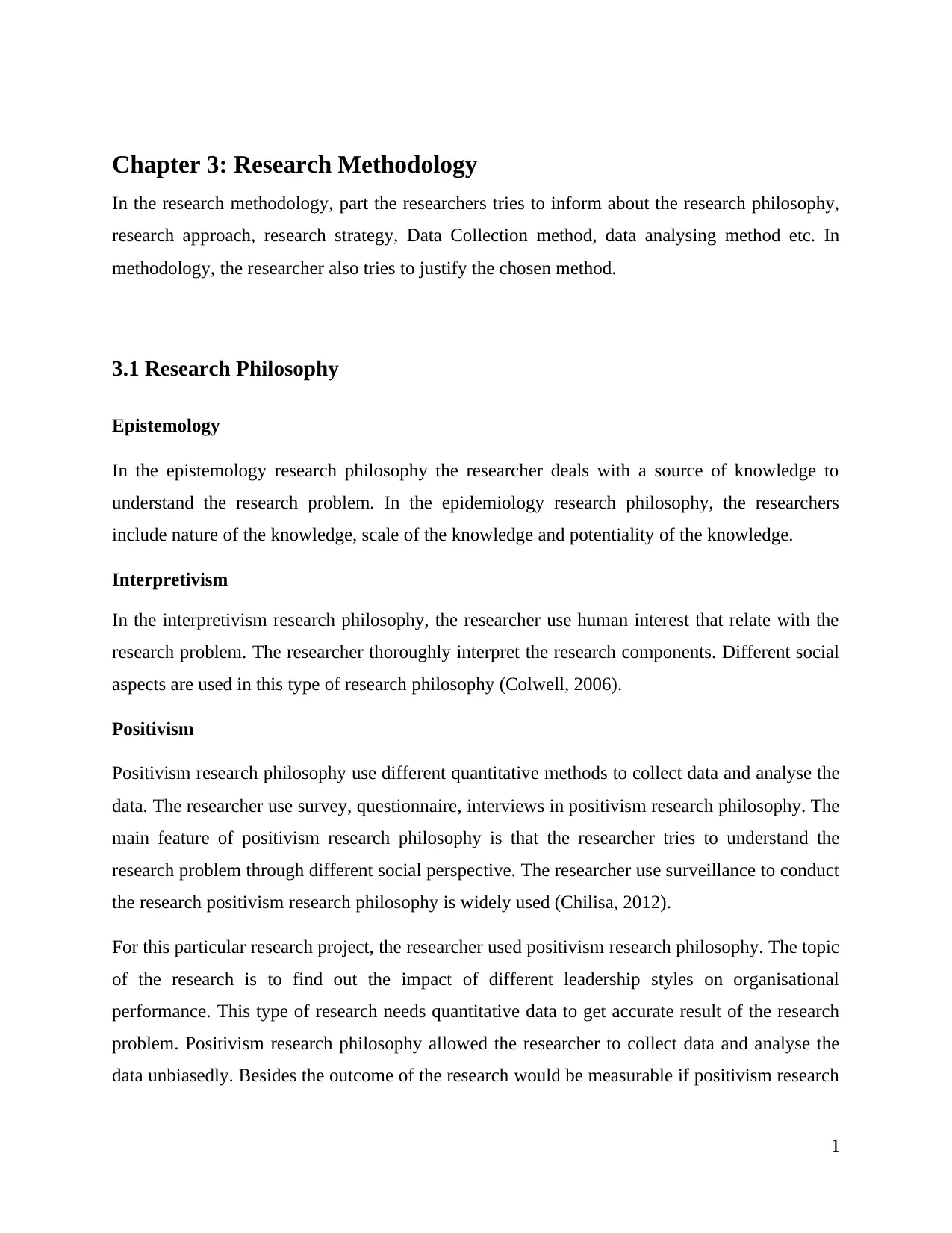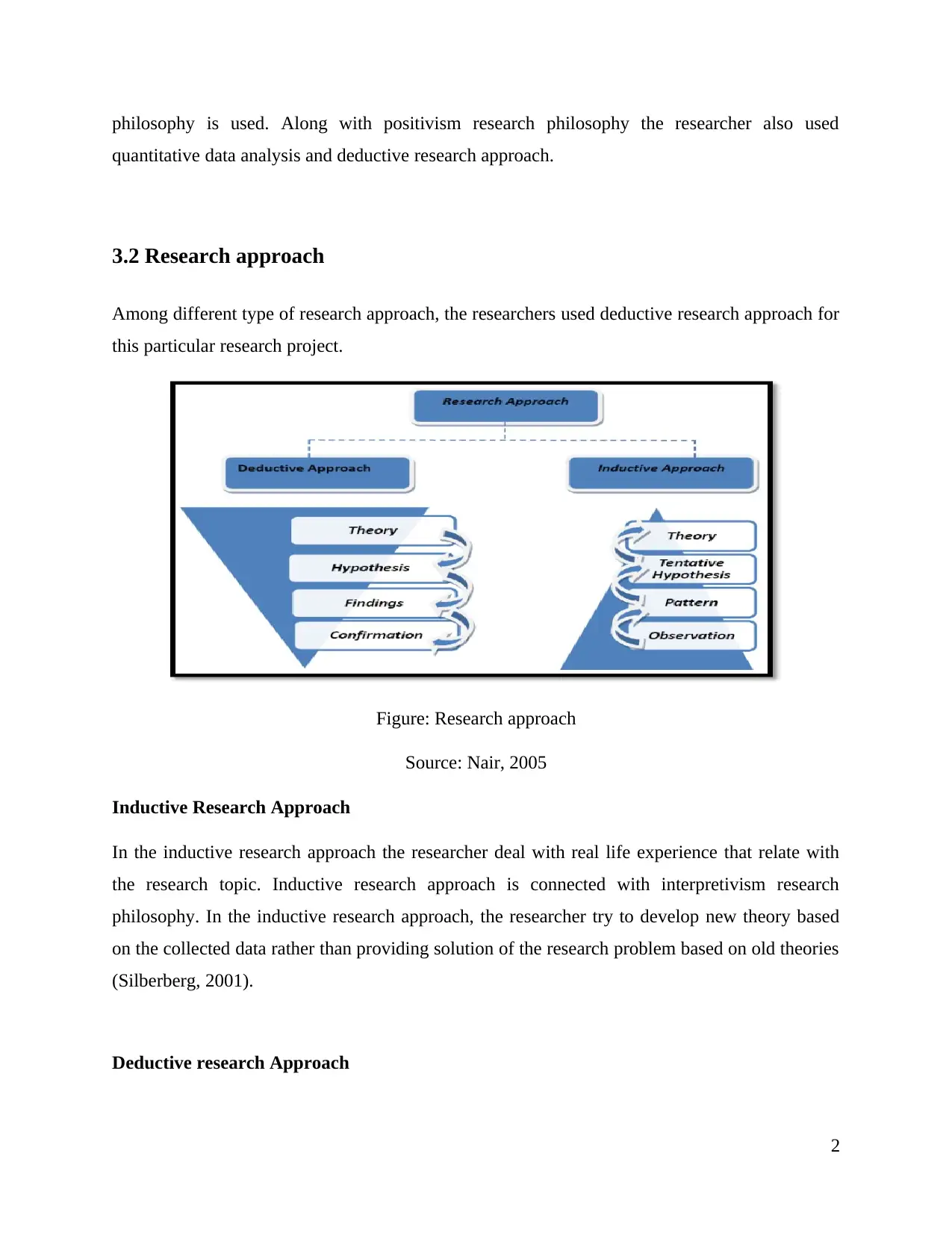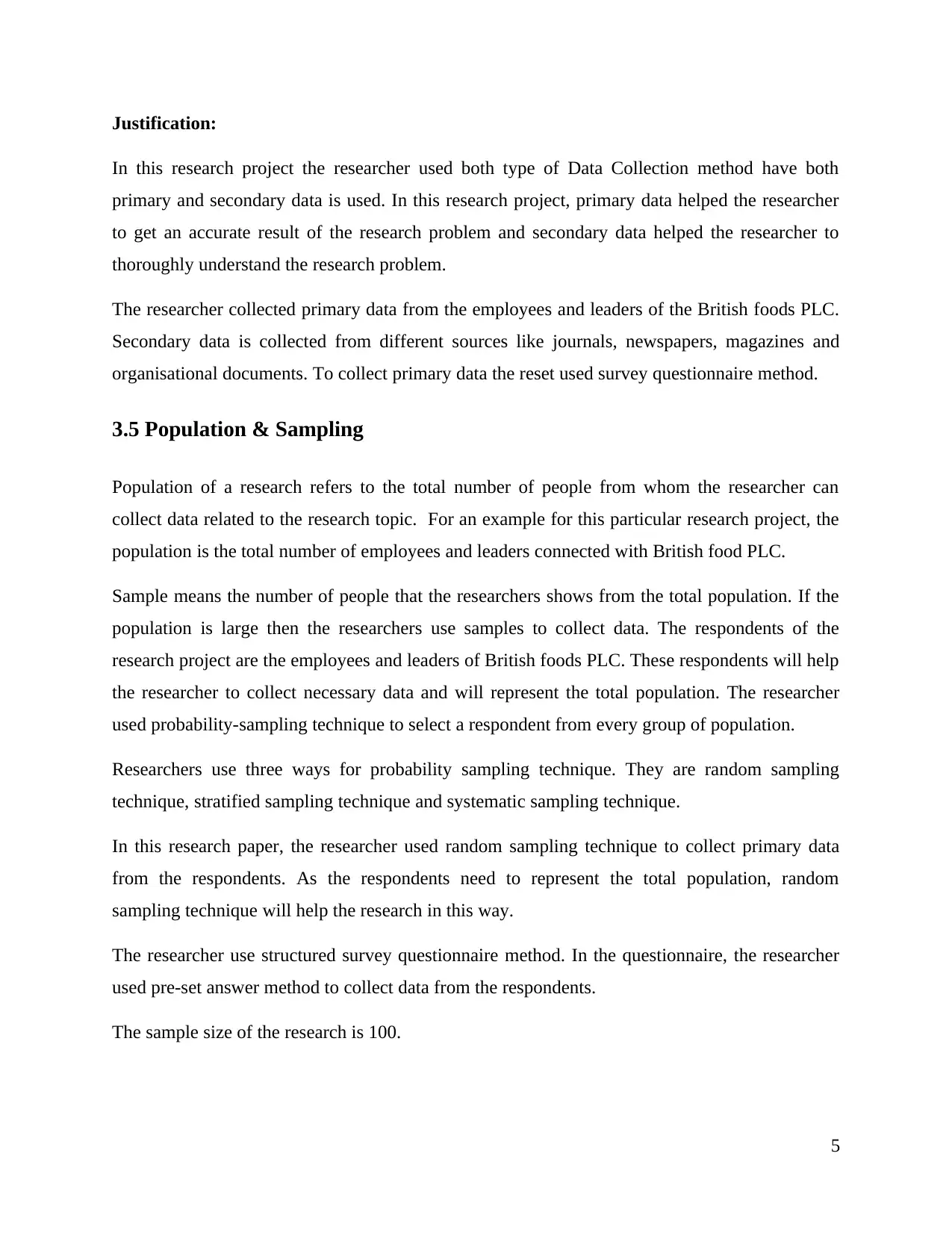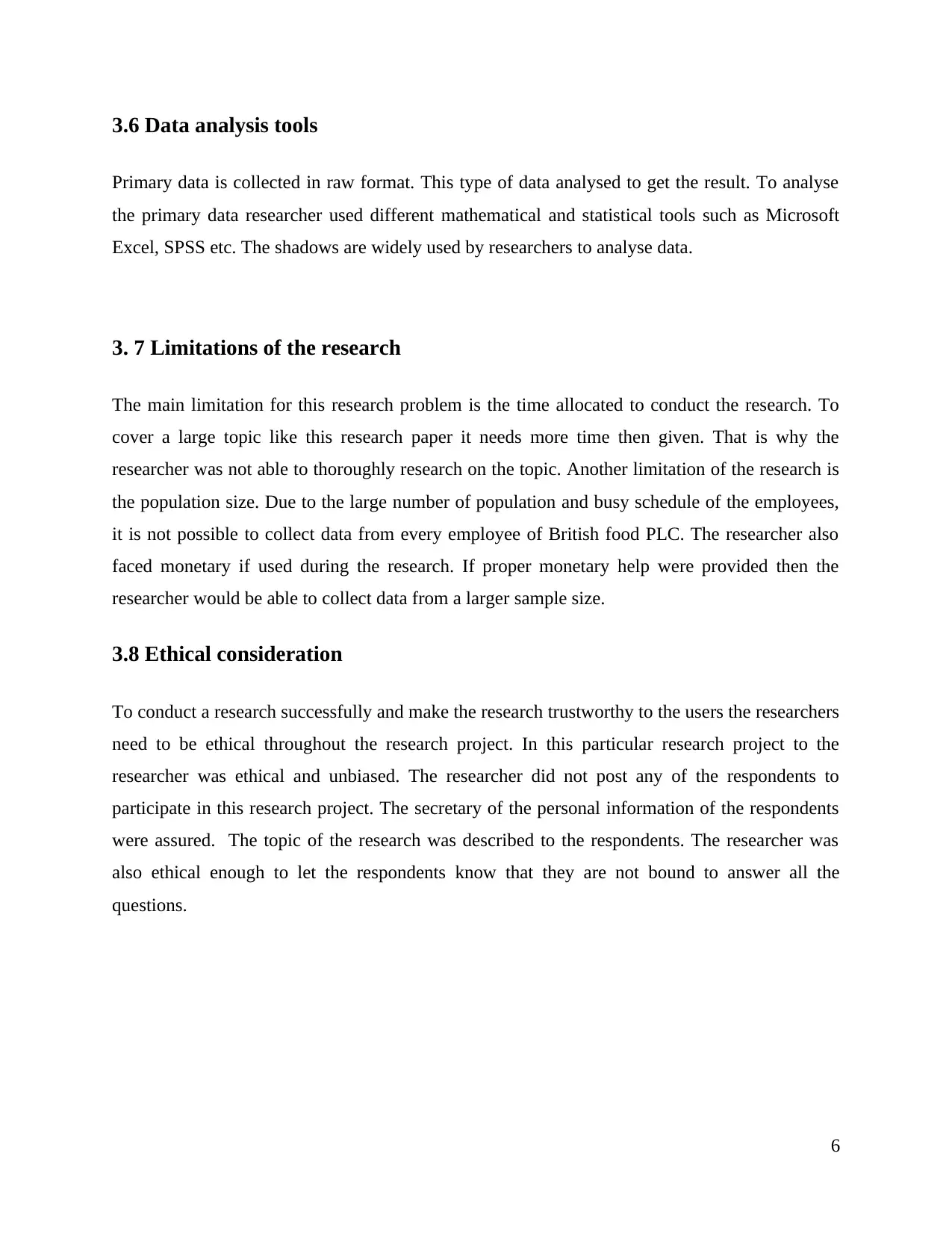Methodology Report: Impact of Leadership Styles on Performance
VerifiedAdded on 2021/03/24
|6
|1639
|82
Report
AI Summary
This report details the research methodology employed to investigate the impact of different leadership styles on organizational performance. The study utilizes a positivism research philosophy, emphasizing quantitative data collection and analysis to achieve measurable outcomes. A deductive research approach is adopted, beginning with hypothesis development and followed by the design of a research strategy to validate these hypotheses. The methodology incorporates a quantitative research strategy, employing surveys and questionnaires to gather primary data from employees and leaders at British Foods PLC. Data analysis is conducted using statistical tools such as Microsoft Excel and SPSS. The research acknowledges limitations including time constraints, sample size, and financial resources, while also highlighting ethical considerations to ensure unbiased and responsible research practices. The report encompasses various aspects of the research process, including research philosophy, approach, strategy, data collection, sampling, and analysis techniques, providing a comprehensive overview of the study's framework and approach.

Chapter 3: Research Methodology
In the research methodology, part the researchers tries to inform about the research philosophy,
research approach, research strategy, Data Collection method, data analysing method etc. In
methodology, the researcher also tries to justify the chosen method.
3.1 Research Philosophy
Epistemology
In the epistemology research philosophy the researcher deals with a source of knowledge to
understand the research problem. In the epidemiology research philosophy, the researchers
include nature of the knowledge, scale of the knowledge and potentiality of the knowledge.
Interpretivism
In the interpretivism research philosophy, the researcher use human interest that relate with the
research problem. The researcher thoroughly interpret the research components. Different social
aspects are used in this type of research philosophy (Colwell, 2006).
Positivism
Positivism research philosophy use different quantitative methods to collect data and analyse the
data. The researcher use survey, questionnaire, interviews in positivism research philosophy. The
main feature of positivism research philosophy is that the researcher tries to understand the
research problem through different social perspective. The researcher use surveillance to conduct
the research positivism research philosophy is widely used (Chilisa, 2012).
For this particular research project, the researcher used positivism research philosophy. The topic
of the research is to find out the impact of different leadership styles on organisational
performance. This type of research needs quantitative data to get accurate result of the research
problem. Positivism research philosophy allowed the researcher to collect data and analyse the
data unbiasedly. Besides the outcome of the research would be measurable if positivism research
1
In the research methodology, part the researchers tries to inform about the research philosophy,
research approach, research strategy, Data Collection method, data analysing method etc. In
methodology, the researcher also tries to justify the chosen method.
3.1 Research Philosophy
Epistemology
In the epistemology research philosophy the researcher deals with a source of knowledge to
understand the research problem. In the epidemiology research philosophy, the researchers
include nature of the knowledge, scale of the knowledge and potentiality of the knowledge.
Interpretivism
In the interpretivism research philosophy, the researcher use human interest that relate with the
research problem. The researcher thoroughly interpret the research components. Different social
aspects are used in this type of research philosophy (Colwell, 2006).
Positivism
Positivism research philosophy use different quantitative methods to collect data and analyse the
data. The researcher use survey, questionnaire, interviews in positivism research philosophy. The
main feature of positivism research philosophy is that the researcher tries to understand the
research problem through different social perspective. The researcher use surveillance to conduct
the research positivism research philosophy is widely used (Chilisa, 2012).
For this particular research project, the researcher used positivism research philosophy. The topic
of the research is to find out the impact of different leadership styles on organisational
performance. This type of research needs quantitative data to get accurate result of the research
problem. Positivism research philosophy allowed the researcher to collect data and analyse the
data unbiasedly. Besides the outcome of the research would be measurable if positivism research
1
Paraphrase This Document
Need a fresh take? Get an instant paraphrase of this document with our AI Paraphraser

philosophy is used. Along with positivism research philosophy the researcher also used
quantitative data analysis and deductive research approach.
3.2 Research approach
Among different type of research approach, the researchers used deductive research approach for
this particular research project.
Figure: Research approach
Source: Nair, 2005
Inductive Research Approach
In the inductive research approach the researcher deal with real life experience that relate with
the research topic. Inductive research approach is connected with interpretivism research
philosophy. In the inductive research approach, the researcher try to develop new theory based
on the collected data rather than providing solution of the research problem based on old theories
(Silberberg, 2001).
Deductive research Approach
2
quantitative data analysis and deductive research approach.
3.2 Research approach
Among different type of research approach, the researchers used deductive research approach for
this particular research project.
Figure: Research approach
Source: Nair, 2005
Inductive Research Approach
In the inductive research approach the researcher deal with real life experience that relate with
the research topic. Inductive research approach is connected with interpretivism research
philosophy. In the inductive research approach, the researcher try to develop new theory based
on the collected data rather than providing solution of the research problem based on old theories
(Silberberg, 2001).
Deductive research Approach
2

In the deductive research approach the researcher primarily develop a hypothesis related with the
research problem and then set research strategy to justify the hypothesis (Kothari and Garg,
2016).
In deductive research approach, the researcher needs to collect quantitative data and use
statistical tools to analyse the data. Deductive research approach is also called top down
approach.
Justification of Research approach
Many researches has been done based on the similar topic of this research. The researcher is
given short time to conduct the research successful and this is one reason to choose deductive
research approach for this research project. The topic of the research requires numeric data to get
accurate result of the research problem. Besides outcome of the research problem should be
measurable to the users. The researcher used positivism research philosophy and deductive
research approach is closely connected with positivism research philosophy. That is why the
researcher used deductive research approach for this research project.
3.3 Research Strategy
There are two types of features strategy. They are qualitative research strategy and quantitative
research strategy.
In the quantitative research strategy, the researcher use numeric data and analyse the data with
different statistical tools to get accurate result of the research problem. Quantitative research is
trustworthy and specific. In quantitative research strategy, the researcher use different
mathematics terms to analyse the collected data that is not biased to any party related with the
research (Welman, Kruger and Mitchell, 2005).
In the qualitative research strategy, the researcher use different theories to explain the research
problem and solution. Description and logical arguments are given in qualitative research
3
research problem and then set research strategy to justify the hypothesis (Kothari and Garg,
2016).
In deductive research approach, the researcher needs to collect quantitative data and use
statistical tools to analyse the data. Deductive research approach is also called top down
approach.
Justification of Research approach
Many researches has been done based on the similar topic of this research. The researcher is
given short time to conduct the research successful and this is one reason to choose deductive
research approach for this research project. The topic of the research requires numeric data to get
accurate result of the research problem. Besides outcome of the research problem should be
measurable to the users. The researcher used positivism research philosophy and deductive
research approach is closely connected with positivism research philosophy. That is why the
researcher used deductive research approach for this research project.
3.3 Research Strategy
There are two types of features strategy. They are qualitative research strategy and quantitative
research strategy.
In the quantitative research strategy, the researcher use numeric data and analyse the data with
different statistical tools to get accurate result of the research problem. Quantitative research is
trustworthy and specific. In quantitative research strategy, the researcher use different
mathematics terms to analyse the collected data that is not biased to any party related with the
research (Welman, Kruger and Mitchell, 2005).
In the qualitative research strategy, the researcher use different theories to explain the research
problem and solution. Description and logical arguments are given in qualitative research
3
⊘ This is a preview!⊘
Do you want full access?
Subscribe today to unlock all pages.

Trusted by 1+ million students worldwide

strategy (Welman, Kruger and Mitchell, 2005). In qualitative research strategy, the researcher
use non-numeric data to justify the research problem (Zikmund, 2013).
Justification of Research Strategy
For the research project, the researcher used quantitative research strategy. As mentioned before
quantitative research strategy provide accurate and specific outcome of the research problem. In
quantitative research strategy, primary data is collected for further analysis. That is why this is
research strategy is trustworthy to every user. The researcher collected primary data through
survey questionnaire method. The researcher used positivism research philosophy along with
deductive research approach and both of these method use quantitative data.
To justify the quantitative research strategy the researcher use different statistical tools and
graphs to present the result of the research problem. That is why quantitative research strategy is
appropriate for this research project.
3.4 Data collection method & Sources of Data
Data Collection refers to the process where the researcher collect necessary data for the research
project. The collected data can be processed or unprocessed. However, it is the duty of the
researcher to ensure that the collected data is suitable and related with the research topic. There
are two types of Data Collection method. They are
Primary data collection method
Secondary data collection method.
In the primary data collection method to the researcher collect data in a raw format. This type of
data neither used nor stored in any media. Researchers use different methods to collect primary
data such as survey, interviews, questionnaires etc. Primary data collection is trustworthy
(McGee, 2007).
Secondary data collection method on the other hand refers to the collection of those data that are
stored or used previously. There are different sources of secondary data such as journals,
newspapers, articles, magazines, websites etc.
4
use non-numeric data to justify the research problem (Zikmund, 2013).
Justification of Research Strategy
For the research project, the researcher used quantitative research strategy. As mentioned before
quantitative research strategy provide accurate and specific outcome of the research problem. In
quantitative research strategy, primary data is collected for further analysis. That is why this is
research strategy is trustworthy to every user. The researcher collected primary data through
survey questionnaire method. The researcher used positivism research philosophy along with
deductive research approach and both of these method use quantitative data.
To justify the quantitative research strategy the researcher use different statistical tools and
graphs to present the result of the research problem. That is why quantitative research strategy is
appropriate for this research project.
3.4 Data collection method & Sources of Data
Data Collection refers to the process where the researcher collect necessary data for the research
project. The collected data can be processed or unprocessed. However, it is the duty of the
researcher to ensure that the collected data is suitable and related with the research topic. There
are two types of Data Collection method. They are
Primary data collection method
Secondary data collection method.
In the primary data collection method to the researcher collect data in a raw format. This type of
data neither used nor stored in any media. Researchers use different methods to collect primary
data such as survey, interviews, questionnaires etc. Primary data collection is trustworthy
(McGee, 2007).
Secondary data collection method on the other hand refers to the collection of those data that are
stored or used previously. There are different sources of secondary data such as journals,
newspapers, articles, magazines, websites etc.
4
Paraphrase This Document
Need a fresh take? Get an instant paraphrase of this document with our AI Paraphraser

Justification:
In this research project the researcher used both type of Data Collection method have both
primary and secondary data is used. In this research project, primary data helped the researcher
to get an accurate result of the research problem and secondary data helped the researcher to
thoroughly understand the research problem.
The researcher collected primary data from the employees and leaders of the British foods PLC.
Secondary data is collected from different sources like journals, newspapers, magazines and
organisational documents. To collect primary data the reset used survey questionnaire method.
3.5 Population & Sampling
Population of a research refers to the total number of people from whom the researcher can
collect data related to the research topic. For an example for this particular research project, the
population is the total number of employees and leaders connected with British food PLC.
Sample means the number of people that the researchers shows from the total population. If the
population is large then the researchers use samples to collect data. The respondents of the
research project are the employees and leaders of British foods PLC. These respondents will help
the researcher to collect necessary data and will represent the total population. The researcher
used probability-sampling technique to select a respondent from every group of population.
Researchers use three ways for probability sampling technique. They are random sampling
technique, stratified sampling technique and systematic sampling technique.
In this research paper, the researcher used random sampling technique to collect primary data
from the respondents. As the respondents need to represent the total population, random
sampling technique will help the research in this way.
The researcher use structured survey questionnaire method. In the questionnaire, the researcher
used pre-set answer method to collect data from the respondents.
The sample size of the research is 100.
5
In this research project the researcher used both type of Data Collection method have both
primary and secondary data is used. In this research project, primary data helped the researcher
to get an accurate result of the research problem and secondary data helped the researcher to
thoroughly understand the research problem.
The researcher collected primary data from the employees and leaders of the British foods PLC.
Secondary data is collected from different sources like journals, newspapers, magazines and
organisational documents. To collect primary data the reset used survey questionnaire method.
3.5 Population & Sampling
Population of a research refers to the total number of people from whom the researcher can
collect data related to the research topic. For an example for this particular research project, the
population is the total number of employees and leaders connected with British food PLC.
Sample means the number of people that the researchers shows from the total population. If the
population is large then the researchers use samples to collect data. The respondents of the
research project are the employees and leaders of British foods PLC. These respondents will help
the researcher to collect necessary data and will represent the total population. The researcher
used probability-sampling technique to select a respondent from every group of population.
Researchers use three ways for probability sampling technique. They are random sampling
technique, stratified sampling technique and systematic sampling technique.
In this research paper, the researcher used random sampling technique to collect primary data
from the respondents. As the respondents need to represent the total population, random
sampling technique will help the research in this way.
The researcher use structured survey questionnaire method. In the questionnaire, the researcher
used pre-set answer method to collect data from the respondents.
The sample size of the research is 100.
5

3.6 Data analysis tools
Primary data is collected in raw format. This type of data analysed to get the result. To analyse
the primary data researcher used different mathematical and statistical tools such as Microsoft
Excel, SPSS etc. The shadows are widely used by researchers to analyse data.
3. 7 Limitations of the research
The main limitation for this research problem is the time allocated to conduct the research. To
cover a large topic like this research paper it needs more time then given. That is why the
researcher was not able to thoroughly research on the topic. Another limitation of the research is
the population size. Due to the large number of population and busy schedule of the employees,
it is not possible to collect data from every employee of British food PLC. The researcher also
faced monetary if used during the research. If proper monetary help were provided then the
researcher would be able to collect data from a larger sample size.
3.8 Ethical consideration
To conduct a research successfully and make the research trustworthy to the users the researchers
need to be ethical throughout the research project. In this particular research project to the
researcher was ethical and unbiased. The researcher did not post any of the respondents to
participate in this research project. The secretary of the personal information of the respondents
were assured. The topic of the research was described to the respondents. The researcher was
also ethical enough to let the respondents know that they are not bound to answer all the
questions.
6
Primary data is collected in raw format. This type of data analysed to get the result. To analyse
the primary data researcher used different mathematical and statistical tools such as Microsoft
Excel, SPSS etc. The shadows are widely used by researchers to analyse data.
3. 7 Limitations of the research
The main limitation for this research problem is the time allocated to conduct the research. To
cover a large topic like this research paper it needs more time then given. That is why the
researcher was not able to thoroughly research on the topic. Another limitation of the research is
the population size. Due to the large number of population and busy schedule of the employees,
it is not possible to collect data from every employee of British food PLC. The researcher also
faced monetary if used during the research. If proper monetary help were provided then the
researcher would be able to collect data from a larger sample size.
3.8 Ethical consideration
To conduct a research successfully and make the research trustworthy to the users the researchers
need to be ethical throughout the research project. In this particular research project to the
researcher was ethical and unbiased. The researcher did not post any of the respondents to
participate in this research project. The secretary of the personal information of the respondents
were assured. The topic of the research was described to the respondents. The researcher was
also ethical enough to let the respondents know that they are not bound to answer all the
questions.
6
⊘ This is a preview!⊘
Do you want full access?
Subscribe today to unlock all pages.

Trusted by 1+ million students worldwide
1 out of 6
Related Documents
Your All-in-One AI-Powered Toolkit for Academic Success.
+13062052269
info@desklib.com
Available 24*7 on WhatsApp / Email
![[object Object]](/_next/static/media/star-bottom.7253800d.svg)
Unlock your academic potential
Copyright © 2020–2025 A2Z Services. All Rights Reserved. Developed and managed by ZUCOL.





